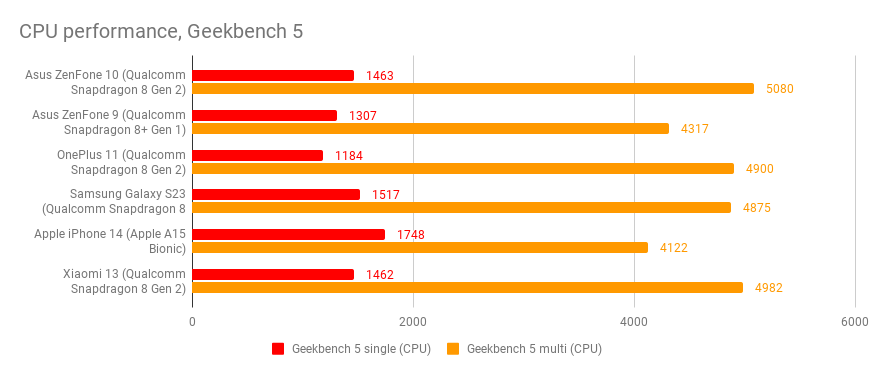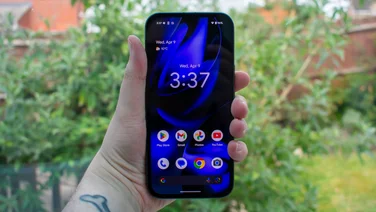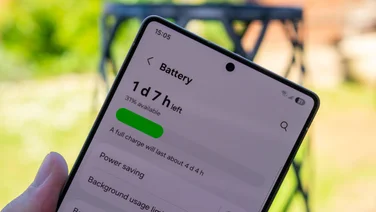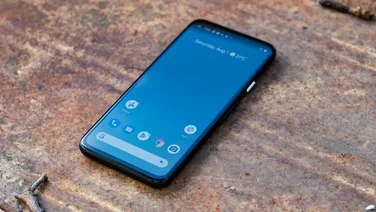To help us provide you with free impartial advice, we may earn a commission if you buy through links on our site. Learn more
- Asus Zenfone 10 review: What you need to know
- Asus Zenfone 10 review: Price and competition
- Asus Zenfone 10 review: Design and key features
- Asus Zenfone 10 review: Display
- Asus Zenfone 10 review: Performance and battery life
- Asus Zenfone 10 review: Cameras
- Asus Zenfone 10 review: Software
- Asus Zenfone 10 review: Verdict









- Wireless charging
- Neat and compact design
- Clean take on Android
- Some software glitches
- Still a few camera issues
- More expensive than the Zenfone 9
Last years Asus Zenfone 9 got us tantalisingly close to the ideal of a true Android-powered compact flagship, with top-notch performance wrapped in a small but stylish form factor. There was clear room for improvement, however, which has us extremely excited to see what the Taiwanese manufacturer can do with the Zenfone 10.
Once again, the onus here is on a flagship experience shrunk down into a more manageable single-handed format. The result is a reliably accomplished small phone, though it would be a stretch to say that its a meaningful step forward from the Zenfone 9.
Asus Zenfone 10 review: What you need to know
As with last years model, the Asus Zenfone 10 is defined by a rare combination of top-notch performance in a much smaller package than weve become accustomed to.
The Zenfone 10 squeezes a Snapdragon 8 Gen 2 processor into a phone with a tiny (by modern standards) 5.9in AMOLED display. The former is a cutting-edge component, while the latter supports up to a 144Hz refresh rate in gaming applications.









That compact design is practically identical to last years model, with the same 4,300mAh battery. Also very similar is the Zenfone 10s dual-camera system, which again features an exceptionally steady 6-axis gimbal system. The most significant improvement over the Zenfone 9 is the addition of 15W wireless charging.
READ NEXT: The best phones for battery life
Asus Zenfone 10 review: Price and competition
As has become the trend, the Asus Zenfone 10 has received a small price bump. It starts at £750 for the model with 8GB of RAM and 256GB of internal storage. Yes, that represents a doubling of storage over the Zenfone 9, but youre still looking at a £50 increase this year.
The upgraded model, with 16GB of RAM and 512GB of storage, is even more expensive at £820 (versus £749 last year). Again, thats a doubling of the storage, but for an even larger £80 increase.
We commented on the Zenfone 9 being £100 more expensive than the Zenfone 8, which means that anyone coming to the end of a two-year contract will be in for a nasty shock.
Perhaps the more important factor is where this price bump positions the Asus Zenfone 10 in the wider market. It sees the range leapfrogging the £729 OnePlus 11 with its superior display and cameras.
In terms of other compact(ish) flagship phones, however, the Zenfone 10 is a whole £100 cheaper than the Xiaomi 13, the Samsung Galaxy S23 and the iPhone 14. Each of those have more premium designs and superior cameras, but theyre also quite a bit bigger.
READ NEXT: The best smartphones to buy
Asus Zenfone 10 review: Design and key features
For better and for worse, Asus has applied pretty much exactly the same design for the Zenfone 10 as it did for the Zenfone 9. In the plus column, I was a big fan of the look of the Zenfone 9, at least from behind. Its bold, flat-edged body and colourful faux leather-like back really set last years phone apart from the Android pack. Asus has switched to a greener bio-based polycarbonate material, but it looks and feels very similar.
True, the Zenfone 10s familiarity means that it doesnt create the same impact as its predecessor, but it still looks unique. Im using the red colour, which contrasts nicely in an early noughties indie band kind of a way with the black aluminium frame. I was also sent the blue model, which looks very smart, while this years signature colour is a leafy green.









IP68 certification makes a welcome return, as does the 3.5mm headphone jack on the top edge. You dont see that very often in modern flagships. Its inclusion perhaps reflects that the Zenfone is rather thick at 9.1mm, but a weight of 172g helps balance things out.
Once again, biometric authentication is handled via a fingerprint sensor housed within a flat power button on the right-hand edge, which can also be gesture-mapped to various touch-sensitive applications. You can have it bring down the notification shade, refresh web pages, control media playback and more.
The downside to Asus sticking with exactly the same design (fresh rear decal aside) is that we get the same disappointing front. I had hoped that the Zenfone 10 would make the bezels more symmetrical, but the bottom edge is still significantly thicker than the top, rather like a cheaper phone. You also get the same reflective selfie camera housing, which again cheapens the impression while using the phone.
Asus Zenfone 10 review: Display
Asus has employed the same 5.9in FHD+ (2,400 x 1,080) Samsung AMOLED display as it did with the Zenfone 9 and the Zenfone 8 before that. I have few complaints, however. It certainly doesnt need to be any sharper, with the smaller size leading to a more pixel-dense picture than any of its FHD+ rivals.
It can even now stretch beyond 120Hz for games, topping out at 144Hz. I found this inclusion to be slightly gimmicky given the dearth of games that support such a resolution, not to mention the fact this isnt a phone that hardcore gamers will be remotely interested in thanks to its small display and battery.









If theres one real criticism, though, its the fact that the Zenfone 10 display doesnt get particularly bright. Asus lists a peak brightness of 1,100cd/m², like before, which is fine rather than spectacular. With auto brightness switched off, I recorded a top brightness of 404cd/m² using a colorimeter, which is just about acceptable. More irksome is the fact that I had to run the phone at maximum brightness most of the time, with a dramatic drop off in visibility as soon as I nudged the brightness slider down.
I had no issue with the colour accuracy of the Zenfone 10 display, however. I switched to the Standard colour mode because it offered much more natural-looking colours than the default Optimal mode, and I measured a gamut coverage of 97.1% against a gamut volume of 97.5%, with an average Delta E score of 0.93. Strong stuff.
Audio is handled by a pair of Dirac-tuned stereo speakers, which output at a decent volume given the size of the phone.
READ NEXT: The best budget smartphones to buy
Asus Zenfone 10 review: Performance and battery life
Performance is arguably one of the Zenfone 10s two main party tricks. Yes, its small, but its also fast. This years model comes with the latest Snapdragon 8 Gen 2 chip, which is a straight up generational upgrade over the Snapdragon 8 Gen 1 of the Zenfone 9. Its paired with up to 16GB of RAM, which my test model uses, though the entry version starts on half that.
The Snapdragon 8 Gen 2 has been impressing all year with its speed. Unsurprisingly, the Zenfone 10s CPU and GPU benchmark results are in keeping with what weve seen from the likes of the Samsung Galaxy S23 and the Xiaomi 13. Theyre also a reasonable amount higher than the Zenfone 9, and much higher than the Pixel 7 with its custom chip.


Interestingly, the Geekbench 5 scores are closer to the Xiaomi 13 Ultra than the Xiaomi 13. Its worth noting that the Ultra was launched and thus tested much more recently than the Xiaomi 13 or the Galaxy S23, so this could simply be a result of a recent tweak or fix to the Geekbench 5 app.
Theres no messing with physics, and the Zenfone 10 can still run hot when you really place it under sustained load. Nevertheless, in general tasks its a strong, fluid performer.
Despite keeping the same modestly sized 4,300mAh battery as before, Asus claims to have achieved a 12.9% battery life improvement over the Zenfone 9. The improvement is certainly dramatic when it comes to running our standard looping video test, where the Zenfone 10 lasted 23hrs 23mins. Thats 5hrs 30mins longer than the Zenfone 9, almost an hour more than the Galaxy S23, and almost seven hours longer than the Xiaomi 13.

In more general everyday use, I found the Zenfone 10s stamina to be broadly similar to the Zenfone 9s. Once again, a 16-hour day with four hours of screen-on time would leave me with about 30% in the tank. Given the compact dimensions of the phone, thats pretty decent, but again, sizing up can get you more.
Asus has supplied a 30W charger with the Zenfone 10, which is far from the fastest. Given the smaller-than-average battery capacity, though, its still good enough to get you from zero to about half full in 30 minutes. Far more consequential is the provision of 15W wireless charging, which felt like a major omission from the Zenfone 9.
Asus Zenfone 10 review: Cameras
Asus has kept things pretty consistent on the camera front, with another dual-camera setup fronted by the same 50MP Sony IMX766 main sensor as the Zenfone 9. As before, the standout component is a 6-axis hybrid gimbal system, which keeps things way more stable than your average OIS system. This enables the shutter to be left open for longer without increasing blur subject permitting as well as steadying video capture.
In practice, the Zenfone 10 is capable of taking sharp, bright, well-balanced shots in both good and bad lighting. Night shots dont let the side down, offering a pleasing level of clarity. You dont have to look too closely to pick up on some noise in darker skies, but its not readily apparent.

The experience in general daytime shooting isnt perfect, however, with a couple of anomalies manifesting themselves. The Zenfone 10 took three attempts to lock on to a close-up of an ice-cream cone in a demanding HDR situation, while on another occasion, zooming in to 2x on a bucolic landscape resulted in an unusually dark scene that contrasted wildly with the well-lit 1x snap from the same angle. Its not the fastest camera, either, with some shots I took in daylight of a pair of pigs slowly trotting along resulting in disappointing amounts of blur. I also noted some grainy artefacts in blue skies when shooting on perfectly sunny days.
I should note that all of these problematic shots were taken before a final firmware update that arrived before submitting my review, so theres a chance Asus has already ironed out some of the creases.
Fix or no fix, ultrawide shots will remain the weak part of the equation, despite the change to a new 13MP sensor with a wider 120-degree field of view. With a much smaller sensor, no OIS and the usual drop-off towards the edges of the frame, ultrawide shots lack the sharpness, richness and all-round quality of 1x snaps. Theyre far from bad, though, and manage to get within the same ballpark on tone.

Zoomed shots are once again handled by cropping in on that main sensor in a space-saving exercise. They look pretty good if you dont stray beyond 2x, but theyre no match for the dedicated telephoto lenses of the Xiaomi 13 and Galaxy S23.
Asus has switched out the Zenfone 9s 12MP front camera for a 32MP component in the Zenfone 10. These pixel-binned 8MP shots look nice and sharp with good skin tones, though the selfie portrait mode isnt too hot at edge detection.
Asus Zenfone 10 review: Software
The Asus Zenfone 10 runs on a pleasingly clean version of Android 13, which will be broadly familiar to anyone who has used a Pixel, Motorola or Sony phone in recent years.
In terms of bloatware, its largely good news. Just about the only hint of duplication on the homepage is an unassuming Gallery app, while the only pre-installed third party apps are Instagram, Facebook and Messenger, which are defensible given their ubiquity.









Asus supplies some of its own custom tools, consigned to its own separate folder, and thats about it. You even get a choice of the Stock Android or Asus Optimised approach when establishing system preferences at setup.
Some of the more interesting software enhancements are tucked away, such as AudioWizard, which lives in the quick settings menu. This gives you a 10-band equaliser and multiple Dirac-tuned audio presets. Its an above-and-beyond feature that largely keeps to the background, which is just the way it should be.
READ NEXT: Best phone camera
Asus Zenfone 10 review: Verdict
The Asus Zenfone 10 is another cool glass of water in a smartphone desert populated by lumbering supersized flagships especially now that the iPhone Mini line is no more. Its small, smart-looking and eminently capable.
The improvements over the Zenfone 9 are admittedly few and far between, and I would have liked to have seen more progress in the design and camera categories, not to mention charging speeds. Its never good to see smartphone prices going up, either, though that appears to be the norm in 2023.
Performance and battery efficiency have taken a step forward, however, and the provision of wireless charging removes one glaring area of compromise from the Zenfone package. Overall, the Zenfone 10 is the best and indeed only genuinely compact flagship on the market, but its one thats still just a few tweaks away from being a definitive statement.






